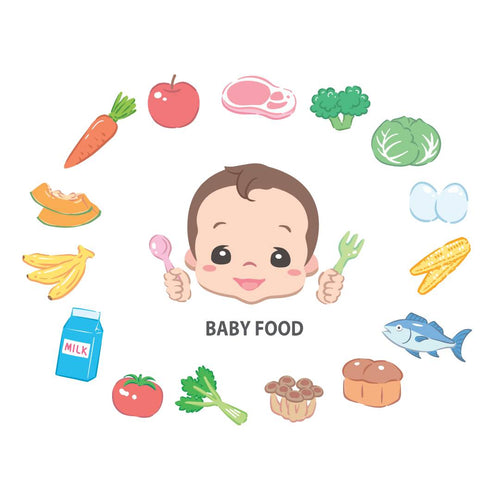This blog is written by the team at Boob to Food
There’s a lot of talk about what to feed babies when starting solids – but not enough conversation about how babies learn to eat.
One of the most important (and often overlooked) parts of learning to eat is developing the skill of chewing. And that’s where hard munchables come in.
So, what are hard munchables?
Hard munchables (sometimes called resistive foods) are firm, fibrous, and safe-to-gnaw foods that your baby can hold and explore - but not actually eat. They're like chew-training tools, helping babies learn to use their jaw, tongue, and lips before they’re expected to manage full meals.
Think:
● Celery stalks
● Lamb chop bones (mostly stripped of meat)
● Mango seeds
● Watermelon rinds
● Corn cobs with most kernels removed
● Pineapple cores
These foods are too firm for babies to bite chunks off, which is exactly the point - they’re about oral exploration, not swallowing. It’s chewing practice without the pressure (for both of you).
Why are hard munchables so helpful?
1. They build jaw strength
Chewing isn’t a reflex — it’s a learned motor skill. The resistance from hard munchables gives your baby’s jaw, tongue, and lips a workout. Strong oral muscles = better eating and safer swallowing down the track (Morris & Klein, 2000; Overland & Merkel-Walsh, 2013)
2. They support sensory learning
Textures, shapes, and mouthfeel all teach your baby how food feels. For babies who are sensitive to new textures, hard munchables offer controlled, consistent input that can make feeding easier in the long run (Arvedson, 2008; Greene, 2010)
3. They’re a safe way to explore chewing
Because babies can't actually bite through them, hard munchables allow babies to learn how to move food side to side, control their tongue, and practise the chewing reflex in a safe, low-risk way (Barlow, 2009; Nederkoorn et al., 2011)
4. They help with teething
Cool, firm foods can bring relief to sore gums and link chewing with positive, comforting sensations (Moimaz et al., 2013)
5. They reduce feeding anxiety
If finger foods feel a bit scary – for you or your baby – hard munchables can be a great first step. They’re developmentally appropriate, gentle, and supportive of both safety and skill-building.
But wait… aren’t big foods dangerous?
It might feel counterintuitive, but large pieces of firm food (like a lamb cutlet or mango pit) are actually safer than small, slippery items like grapes or cherry tomatoes. Why? Because babies have to actively chew and explore, rather than accidentally gulping.
How to introduce hard munchables safely
● Start slow and follow your baby’s cues
● Always supervise closely – sit with your baby while they explore
● Choose firm, whole foods that are too hard to bite through
● Skip soft, breakable foods – if it dents easily with your nail, it’s not firm enough
● Keep size in mind – bigger than your baby’s fist, with a handle they can grip
● Pair with a dip or a naturally puréed food for added fun
If you’re feeling nervous, try using a Haakaa Fresh Food Feeder. You can pop in a firm food like a frozen slice of mango - your baby gets texture, sensory feedback, and soothing relief for teething all in one, with extra peace of mind for you.
You’ve got this
Starting solids doesn’t have to be scary. Hard munchables are a gentle, practical way to build the chewing skills your baby needs – and your confidence too. Whether it’s a celery stick, a mango pit, or a Haakaa feeder full of frozen pumpkin purée, every little chew is a step toward confident eating.
For more on texture progression, safety, and introducing solids confidently, you’ll find an entire chapter on this in our book Milk to Meals.
From the team at Boob to Food
Luka McCabe
Rachael Smith (Paediatric Occupational Therapist)
Emily Tyler (Speech Pathologist)
References
Arvedson, J. C. (2008). Assessment of pediatric dysphagia and feeding disorders: clinical and instrumental approaches. Developmental Disabilities Research Reviews, 14(2), 118–127. https://doi.org/10.1002/ddrr.17
Barlow, S. M. (2009). Oral and respiratory control for preterm feeding. Current Opinion in Otolaryngology & Head and Neck Surgery, 17(3), 179–186. https://doi.org/10.1097/MOO.0b013e32832b36fe
Greene, Z. (2010). Oral sensory integration and feeding in infants and toddlers. In R. A. Kerwin (Ed.), Pediatric feeding disorders manual (pp. 143–158). Springer Publishing.
Moimaz, S. A. S., Zina, L. G., Saliba, O., Saliba, N. A., & Sumida, D. H. (2013). Natural methods for alleviating the discomfort of teething in infants. European Journal of Paediatric Dentistry, 14(3), 223–225.
Morris, S. E., & Klein, M. D. (2000). Pre-feeding skills: A comprehensive resource for mealtime development (2nd ed.). Therapy Skill Builders.
Nederkoorn, C., Smulders, F. T. Y., & Jansen, A. (2011). Cephalic phase responses, craving and food intake in normal subjects. Appetite, 56(2), 244–249. https://doi.org/10.1016/j.appet.2010.12.016
Overland, L., & Merkel-Walsh, R. (2013). Functional assessment and remediation of chewing skills. TalkTools.https://www.talktools.com
Toomey, K. (n.d.). SOS Approach to Feeding. https://sosapproachtofeeding.com/why-sos-approach-feeding/

